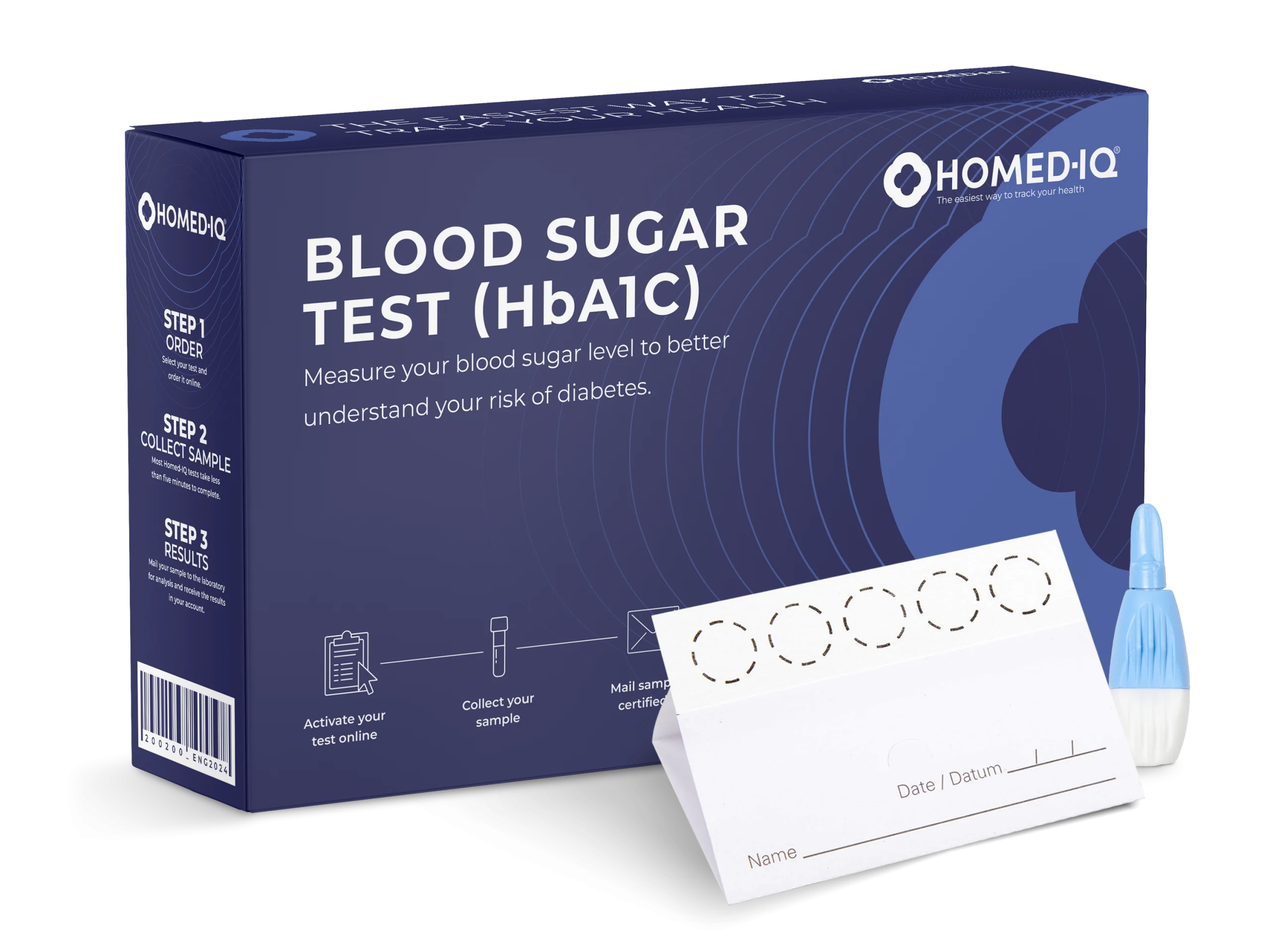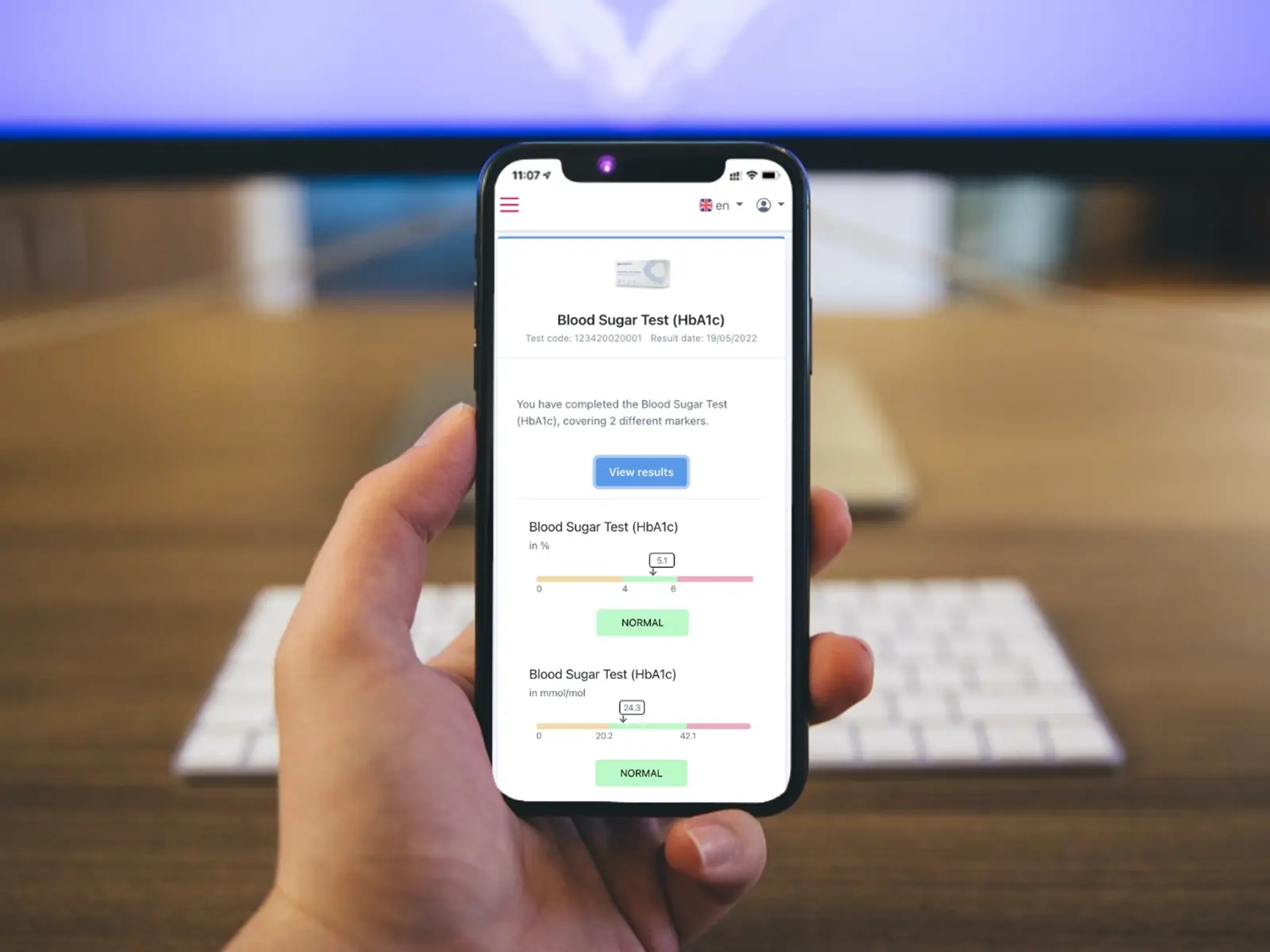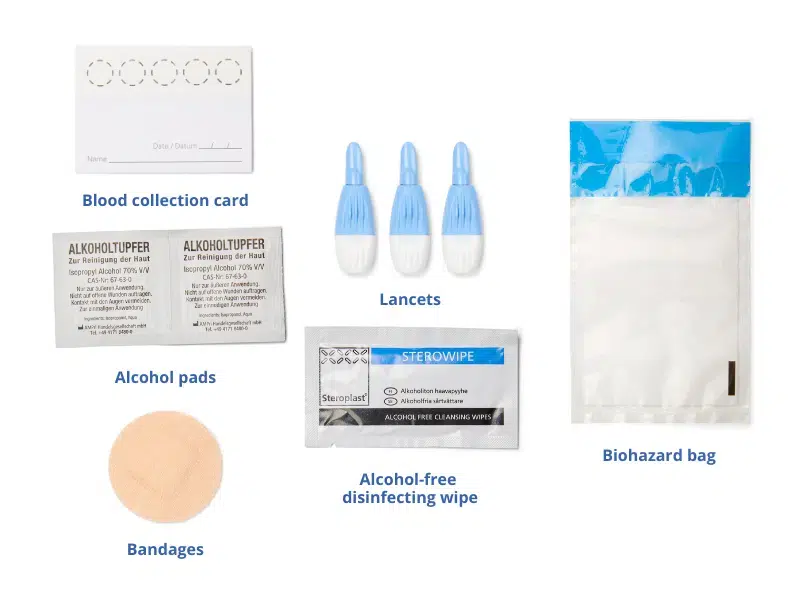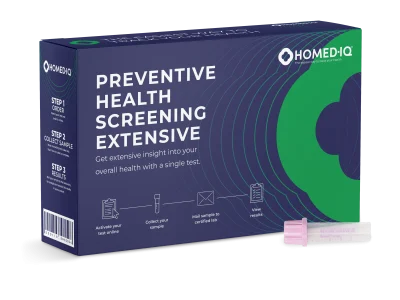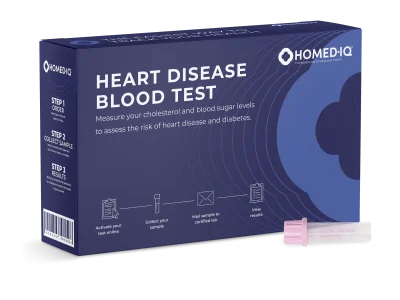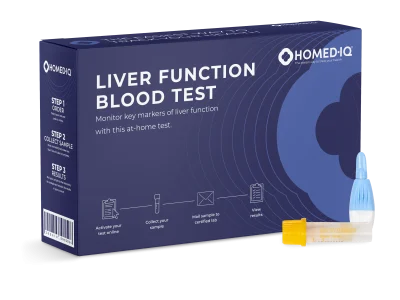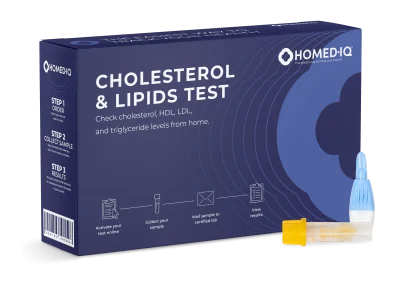

Blood Sugar Test (HbA1c)
€45,00
Free Shipping to
Do you think you may have diabetes or pre-diabetes? Diabetes is a disease in which your body can’t make insulin or use it effectively to control blood sugar. While diabetes is a highly common disease, some people do not know they have it as they have no symptoms. Learning your blood sugar level means that treatment or preventive lifestyle changes can be implemented if needed. This test measures the HbA1c level in your blood, indicating your average blood sugar level over the past three months. If it is too high, this may indicate pre-diabetes or diabetes.
Test Method: Finger prick dry blood spot test
What do we test for?
About HbA1c
The term HbA1c stands for ‘hemoglobin A1c’, or glycated hemoglobin. Hemoglobin is a protein found in red blood cells, giving them their color. Hemoglobin in blood carries oxygen from the lungs to the rest of the body. Glucose (sugar) in the blood can also attach to hemoglobin, known as glycated hemoglobin. This means that the more glucose there is in the blood, the more glycated hemoglobin there is. Because red blood cells (and therefore also hemoglobin in the red blood cells) live for a maximum of 120 days, an HbA1c value provides insight into the average blood glucose level over the past 10 to 12 weeks. The higher the glucose level has been during the period of time before the test, the higher the HbA1c value will be.
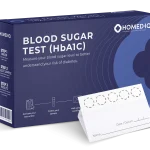
€45,00
Free Shipping to
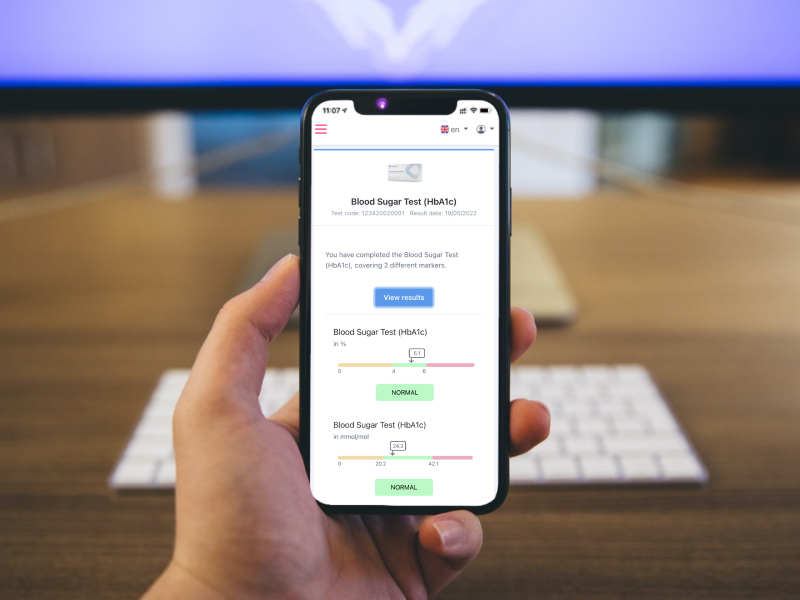
How does a blood sugar test work?
If you are interested in your average blood glucose levels or if you want to gain insight into your body’s glycemic control, an HbA1c blood test that you can perform from home is a simple, effective testing method. An HbA1c blood test is used, among other things, to diagnose diabetes and to monitor people with diabetes.
An HbA1c test is a blood test that measures the average blood glucose (blood sugar) value over the past 3 months. Glucose is a sugar in the blood that sticks to hemoglobin, a protein found in red blood cells. The more glucose there is in the blood, the more red blood cells will have glucose-coated hemoglobin (HbA1c). Red blood cells have a lifespan of approximately 3 months and are constantly renewing in the body. The test result will indicate whether your average blood glucose value over the past 3 months is within or outside the reference values. If your HbA1c value is too high, this can mean you may have diabetes or pre-diabetes.
What is HbA1c?
Assessing blood sugar level with an HbA1c test is different from using a blood glucose meter (or glucometer) to measure your blood sugar. A glucose meter measures your blood glucose levels at that moment, providing a snapshot of blood sugar level. However, blood sugar levels can change significantly during the day in response to the composition of the different meals you eat and your level of physical activity. Since an HbA1c test provides an average of blood sugar levels over the past three months, it can be useful for long-term preventive monitoring. HbA1c tests are often used to diagnose diabetes, as well as monitor the treatment of diabetes and pre-diabetes.
Another useful self test from our General Health Tests category is our Preventive Health Screening. With this test, you can not only check your HbA1c, but also many other important biomarkers!
What is diabetes?
Diabetes is a chronic condition that occurs when blood sugar (glucose) is too high. This may be due to insufficient insulin production by the pancreas or insufficient use of insulin by the body. Uncontrolled diabetes can lead to serious complications such as kidney damage, neuropathy, blindness and cardiovascular disease.
Diabetes comes in two forms: type 1 diabetes and type 2 diabetes. Type 1 diabetes is an autoimmune condition in which your body attacks the insulin-producing cells in the pancreas. Type 1 diabetes needs to be managed by regularly taking insulin to control blood sugar. Type 2 diabetes occurs when your body is unable to make enough insulin or use insulin effectively. Type 2 diabetes may come on more gradually than Type 1, making it hard to recognise in the beginning. Type 2 diabetes can be managed with lifestyle changes (diet, exercise, and weight loss) or medication. People with type 2 diabetes can also take insulin.
What is prediabetes?
Prediabetes occurs when blood sugar levels are higher than normal, but not high enough to be diagnosed as type 2 diabetes. People with prediabetes have an increased risk of developing type 2 diabetes, as well as other health problems such as cardiovascular disease. An HbA1C level between 6.0% and 6.5% often indicates prediabetes, also known as the stage before type 2 diabetes.
Without lifestyle changes, both adults and children with prediabetes have an increased risk of developing type 2 diabetes. Long-term damage from diabetes – particularly to the heart, blood vessels and kidneys – may have already begun in prediabetes. However, there is good news: prediabetes is reversible through lifestyle changes, such as adequate exercise and weight loss.
Why is HbA1c important to measure?
- HbA1c values show average blood glucose values over an extended period of time.
- A good HbA1c level protects your blood vessels and the nervous system.
- A good HbA1c level is a precondition for well-controlled diabetes.
Why is diabetes or an elevated HbA1c level harmful to health?
Most foods that we eat are broken down into sugar (glucose) and released into our bloodstream. An increase in blood sugar signals for your pancreas to release insulin, which allows your body cells to use blood sugar for energy. People with diabetes either do not produce enough insulin, or cells become less responsive to insulin with time. This means that excess sugar remains in the blood and will be continuously pumped around your body. High blood sugar eventually causes major damage such as heart disease, nerve damage, and vision problems. This is why it is very important to monitor blood sugar levels and recognize diabetes or pre-diabetes.
Who is this test suitable for?
This test for diabetes is suitable for anyone who may recognize the symptoms in the “symptoms” section and thinks they have diabetes or pre-diabetes. The test is also suitable if you have diabetes in your family and would like to monitor your blood sugar, or if you have previously been diagnosed with diabetes and would like to know how well you have your diabetes under control.
Common symptoms of diabetes or pre-diabetes are:
- Thirst
- Frequent urination
- Weight loss or gain
- Fatigue
- Sugar cravings
- Irritated easily
- Nausea
- Blurred vision
Learn more about the symptoms of type 1 and type 2 diabetes on our blog.
HbA1c
The term HbA1c stands for ‘hemoglobin A1c’, or glycated hemoglobin. Hemoglobin is a protein found in red blood cells, giving them their color. Hemoglobin in blood carries oxygen from the lungs to the rest of the body. Glucose (sugar) in the blood can also attach to hemoglobin, known as glycated hemoglobin. This means that the more glucose there is in the blood, the more glycated hemoglobin there is. Because red blood cells (and therefore also hemoglobin in the red blood cells) live for a maximum of 120 days, an HbA1c value provides insight into the average blood glucose level over the past 10 to 12 weeks. The higher the glucose level has been during the period of time before the test, the higher the HbA1c value will be.
What’s in the test kit?
This diabetes test kit contains:
- Instructions for use
- Lancets to collect a small blood sample
- A dry blood spot blood collection card
- Alcohol wipes
- Band-aids
- A protective transport bag
- A return envelope to send your sample to a certified partner laboratory
What is the test process for Homed-IQ’s Blood Sugar Test?
Homed-IQ’s Blood Sugar Test comes with everything you need to successfully take a blood sample from home. Simply activate your test and follow the supplied instructions to collect the sample and then send it to our certified laboratory using the prepaid shipping label. The results will be available within a few days of arriving in the lab.
How soon will I receive my test results?
Once you have collected your sample and then mailed it to our laboratory, it generally takes a few working days before you receive the test result. As soon as your test sample arrives at the laboratory you will receive a notification by email. Once your test result is ready, you will receive a text message and an email from us with a link to your test result. We will therefore keep you well informed throughout the entire testing process!
What does the result of this test mean?
The result of this test shows what your average glucose level has been over the past 3 months. If this value deviates from the target range, this may indicate pre-diabetes or diabetes. In this case, consult your doctor so that he or she can establish the diagnosis.
Which HbA1c value indicates diabetes?
- An HbA1c of less than 5.7% means that your blood sugar levels are normal and that you do not have diabetes, or your diabetes is under control.
- An HbA1c between 5.7% and 6.5% may mean that you have prediabetes, also known as impaired glucose intolerance. This is the preliminary stage of type 2 diabetes, and is a reversible condition. If your test results indicate prediabetes, contact your doctor discuss lifestyle changes that can be made to prevent the progression to type 2 diabetes.
- An HbA1c of 6.5% or higher means that you have type 1 or type 2 diabetes. Please contact your doctor for further testing.
Frequently asked questions
Who is this blood sugar test suitable for?
Is this HbA1c home test suitable for pregnant women?
How reliable is Homed-IQ's testing process?
Is this HbA1C blood test an alternative to a blood test performed at the doctor?
Can this test be used to diagnose type 1 diabetes?
Why is it important to measure your blood sugar?
How often should I perform a HbA1c test?
Are there ways to lower blood glucose levels?
- Exercise regularly, for at least 30 minutes a day
- Follow a balanced diet with lots of fruits and vegetables
- Do not drink sugary soft drinks or juices
- Drink enough water
- Avoid stress
- Get enough and regular sleep
- Limit alcohol consumption
